Stanford Law Students Helping Asylum Seekers at the US-Mexico Border
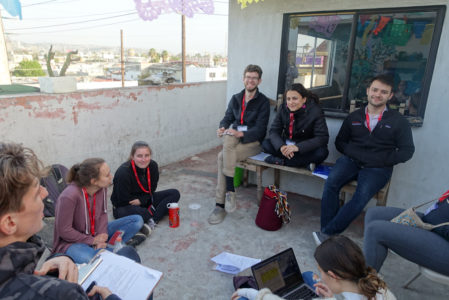
This year, more than 50 Stanford Law School (SLS) students joined the Tijuana-based legal services organization Al Otro Lado to help asylum seekers from all over the world. Over the course of three trips, we consulted hundreds of asylum seekers about their rights, conducted research for civil rights litigation, and provided humanitarian support to some of the estimated 30,000 asylum seekers who have arrived in Tijuana since last fall.
We crossed the border to Mexico by foot at the San Ysidro port of entry, then walked about a mile to Al Otro Lado’s Tijuana office. Luis Guerra, a lawyer with the Catholic Legal Immigration Network who coordinates Al Otro Lado’s volunteers, greeted us over the sounds of mariachi music and chatter of passersby emanating from the street below. After introductions, Luis described the unofficial metering system in place since 2018, which limits the number of people who can enter the United States to request asylum each day. Those hoping to request protection in the United States must report to the port of entry in the early morning to add their names to a handwritten list overseen by asylum seekers themselves. Each morning, the Department of Homeland Security communicates to Mexican officials the number of asylum seekers it will allow to enter that day—ranging anywhere from zero to sixty people. List managers call a corresponding number of names from the list. The metering system has left thousands waiting months in Tijuana for their turn to request protection in the United States.
Luis described the danger asylum seekers face while they wait in Tijuana, which ranks among the world’s most dangerous cities. He told us that last December, two teenage asylum seekers were abducted, tortured, and murdered outside their youth shelter while they awaited the opportunity to request asylum in the United States. The boys had received services in the Al Otro Lado office shortly before their death. Luis advised us that organized crime networks in Mexico collaborate with gangs in other parts of Central America to locate people on the run. Earlier that week, in fact, Luis had removed suspected gang members posing as asylum seekers from the office. He warned us that Al Otro Lado lawyers had recently received death threats from Colombian cartel members seeking information about an asylum client.
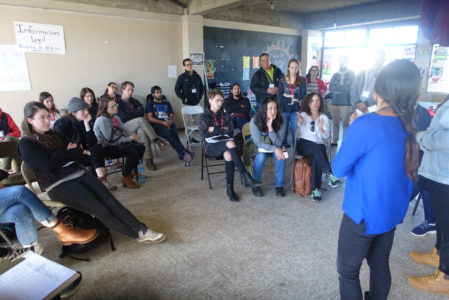
Luis led us through a meditation exercise and discussed strategies for managing the effects of secondary trauma. Once I began assisting with individual client consultations, I understood why. A seventeen-year-old boy from Honduras described being harassed by the gang that controlled his neighborhood, then finding his cousin burned alive. A Russian LGBTQ rights activist recounted, through tears, being beaten by law enforcement officers and refused care in the hospital. A Cameroonian man whose village was burned by government forces told me he was imprisoned and tortured for leading educational seminars. He had not spoken with his wife and children in months and did not know if they were alive. A Mexican mother showed me pictures of her 16-year-old daughter’s body; bound, gagged, and left on her front lawn with a note from a gang threatening to kill the rest of the family. The people we met were literally fleeing for their lives.
The asylum seekers in Al Otro Lado’s office recalled long, harrowing journeys by foot across Central America, where many fell victim to theft, extortion, or sexual abuse, leaving them without basic necessities as they wait in Tijuana for the opportunity to enter the United States to request protection. Immigrants rely on limited spaces in government or privately-run shelters and the generosity of organizations providing meals and medical services. Shelter conditions are rough.
On our first trip to the border last fall, Hannah Matsunaga (JD ’19) and I traveled with an immigration attorney to El Barretal—an abandoned nightclub about a 30-minute drive from the border that the Mexican government had converted into a shelter. At the time, there were about 2,500 immigrants living there, including unaccompanied minors and families with small children. We arrived wearing bright orange hats displaying the words “Asilo E.E.U.U.” (United States Asylum). Shelter residents immediately swarmed us with questions about the process of requesting asylum in the United States; lines formed, and the questions continued for about five hours. The camp was crowded, with tents propped corner to corner on multiple levels of concrete floors. Everyone was sick.
Perhaps the hardest part of our job was explaining to the people we met, after all they had endured, the challenges awaiting them on the other side. We advised them to wear their warmest layer on the bottom, because they would initially be transferred to a holding cell known among Spanish-speakers as the “hielera” (the icebox), because the cell is kept extremely cold. United States officers would seize all immigrants’ belongings except for the clothing layer worn closest to their bodies and give them only a small foil “blanket.” They would be held there for a few hours to a few days in unsanitary conditions with limited access to food and water, with lights on for 24 hours a day. They might be separated from their loved ones and could be transferred to detention centers thousands of miles apart. We told them they would likely wait in detention for months before their asylum claims would be adjudicated. We told them that if their claims did not satisfy the narrow criteria for obtaining United States asylum, they would likely be deported.
By our second visit to Tijuana in January, Al Otro Lado was no longer allowing volunteers to travel to shelters due to safety concerns. Organized crime groups had established presences in many shelters. Human trafficking had become rampant. By our third visit in March, the government had closed El Barretal. We assisted with operations in Al Otro Lado’s office, with SLS students taking the lead on many of the organization’s daily projects. Each afternoon, Al Otro Lado opens its office doors to immigrants in need of legal services. Close to 50 immigrants, mostly people seeking asylum in the United States, pass through the office on a given day. Each day, volunteers lead “charlas” or know-your-rights trainings, for large groups of guests in a lecture-style room. Volunteers review US asylum law and explain what asylum seekers should expect after passing through the port of entry. Cynthia Amezcua (JD ’19), Phil Wilkinson (JD ’21) and Grace Rybak (JD ’21) led the Spanish language charlas; and Guilluame Braidi (LLM ’19) led the French language charla. Charla leaders reviewed the basic requirements of an asylum claim under US law. They also described what to expect on the other side—including the likelihood of prolonged periods of detention in difficult conditions and the possibility that children would be separated from their parents.
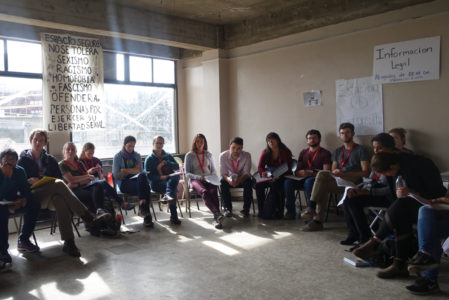
The bulk of SLS students’ work involved assisting with “consultas,” or individual consultations with attorneys and asylum seekers. SLS students, under the supervision of immigration attorneys, met individually with asylum seekers to gather information about their cases and inform them about United States asylum law. Rachel Sohl (JD ’21) designed a streamlined system to match asylum seekers with volunteers that has remained in place since our departure. Jasmine Miller (JD ’19) reorganized the space and coordinated donations of new supplies to keep the children entertained while their parents consulted attorneys.
Mallorie Urban (SLS ’21), Michael Abrams (SLS ’19), and Karmpreet Grewal (SLS ’20) led the document collection service. They scanned important documents like birth certificates, identification cards, photos and other documents crucial to supporting asylum seekers’ claims. They uploaded them to online cloud accounts, so asylum seekers would be able to access copies of their documents remotely in case they were lost or stolen. Mallorie created a guide with resources and instructions for volunteers to improve the process. By the end of their visits, they were training new volunteers.
Other SLS students worked on legal research projects to support federal litigation to protect immigrants’ rights. Some students tracked the locations of asylum seekers who had passed through Tijuana and landed in detention centers in the United States. Ashley Brooks (JD ’20) led a research team to create marriage certificates for couples from several central American countries so Al Otro Lado could conduct legal weddings to help couples stay together through the asylum process. Some SLS students reported to the border at seven each morning to observe the “list” process and prepare asylum seekers for their credible fear interviews before presenting themselves at the port of entry. When they were not doing legal work, SLS volunteers served hot meals to migrants, purchased supplies, and spent time connecting asylum seekers with social services, medical care or shelters.
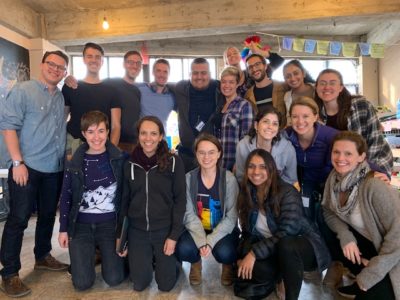
The scope of need in Tijuana is vast. As of this writing, there are about 9,000 people waiting on “the list” for their turn to request asylum. The average wait time to enter the United States is seven months. But numbers and news reports can only tell so much. Cynthia Amezcua (JD ’19) said that engaging with impacted people firsthand gave her a new perspective. “The individuals we serve are some of the strongest, most resilient individuals in the world. They can be an example to us all and a reminder of how our country’s actions impact the real lives of others abroad. And being on the ground makes a huge difference. So much of the rhetoric around migration has focused on Central America. Once there, I realized how many immigrants have arrived from Haiti and various countries in Africa. This made me realize how our national consciousness has made a population invisible, which impacts the amount of resources and support that’s provided.”
Jake Sonnenberg (JD ’20) said the experience was particularly meaningful in the context of his own lived experience. “My own family came to this country fleeing persecution in Eastern Europe, and I’d never before seen personally how our immigration laws shatter people’s lives arbitrarily and prevent those in danger from finding refuge. Many of the people I worked with had so much in common with me that it was difficult to comprehend how differently the United States government was treating us… Our work didn’t offer easy solutions to anyone, and the vast majority of our clients’ stories are unlikely to end with winning asylum in the United States. Walking across the border back to the United States, we completed in 10 minutes a journey that will take our clients — if they are immensely lucky — months of travel and persecution followed by prolonged incarceration in American detention centers. Volunteering for four days with Al Otro Lado was the most meaningful legal experience I’ve had here at the law school.”
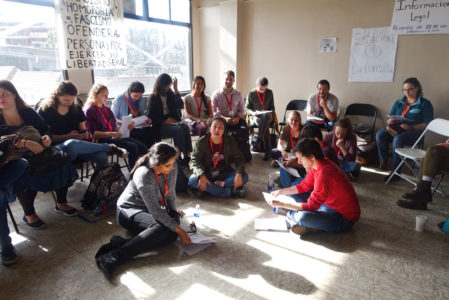
The work of SLS students on these issues did not end when we left Tijuana. After returning, ten of us, led by JSD students Diana Guzmán Rodríguez and Thiago Reis, met weekly through the spring quarter to draft a report on human rights issues at the border for advocacy within the Inter-American system. Under the supervision of Professor Beth Van Schaack, we coordinated with various human rights organizations to compile research and document conditions on the ground. I will spend a few weeks collecting updated information in Tijauna this summer, and we will see this project to completion next fall with the assistance of the Stanford International Human Rights Clinic. Some of us helped Al Otro Lado stay in contact with asylum seekers we met in Tijuana to connect them to pro bono services in the United States. In September, a group of ten SLS students will return to volunteer with Al Otro Lado on a Levin Center- sponsored Alternative Summer Break trip.
The U.N. High Commissioner for Refugees reported that a record 70.8 million people were forcibly displaced by violence in 2018. With numbers like these, any action we can take to help feels like a drop in the bucket. But with so much human suffering at our southern border only a few hundred miles away from our campus, the work of the many SLS students who have worked in Tijuana has helped deliver a small bit of justice to those impacted by a deeply broken system.
Julia Neusner is a joint degree student pursuing a JD at Stanford Law School and an MA in International Policy at the Freeman Spogli Institute for International Studies. Julia started the Stanford Asylum Project, through which she led three volunteer trips to Tijuana funded by the Stanford Public Interest Legal Foundation, the Levin Center, and Dean Magill. Julia will return to Tijuana this summer to continue research into human rights issues at the border.
